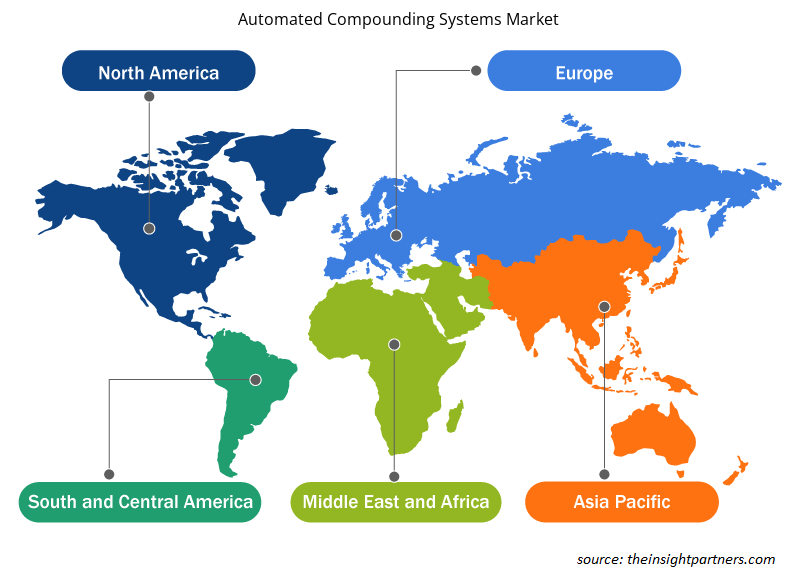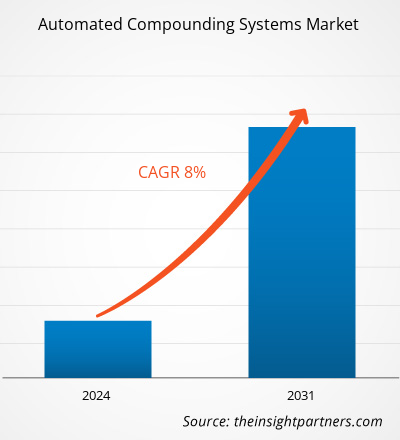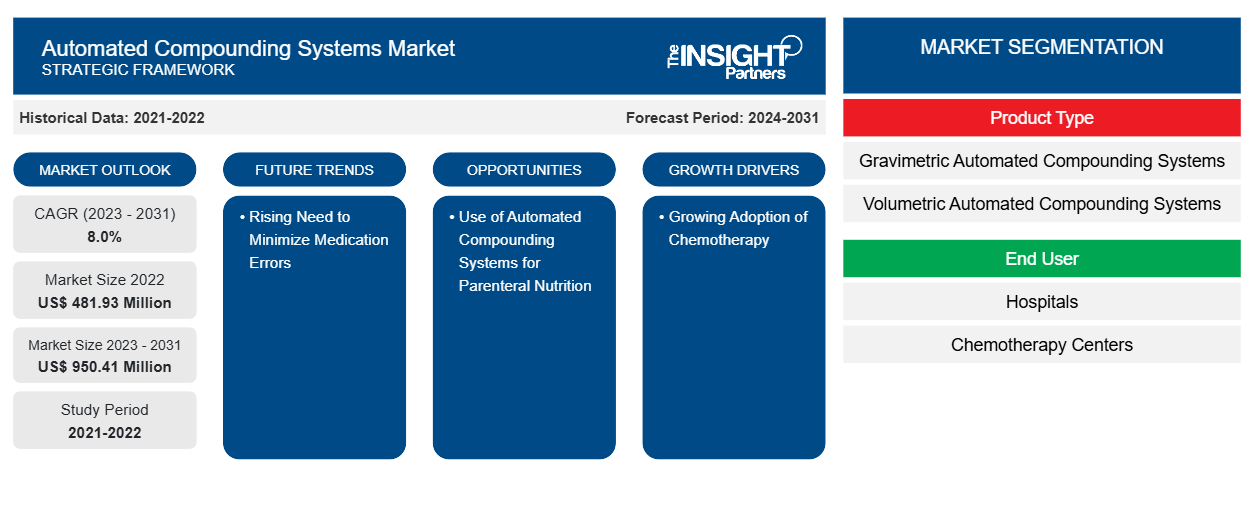La taille du marché des systèmes de composition automatisés a été estimée à 481,93 millions USD en 2022 et à XX millions USD en 2023 et devrait atteindre 950,41 millions USD d'ici 2031 ; elle devrait enregistrer un TCAC de 8,0 % jusqu'en 2031. Les développements stratégiques et les lancements de produits devraient rester les principales tendances du marché des systèmes de composition automatisés.CAGR of 8.0% till 2031. Strategic developments and product launches are likely to remain key Automated Compounding Systems Market trends.
Analyse du marché des systèmes de préparation automatisés
La demande croissante de médicaments personnalisés, l'amélioration de la sécurité des patients, les réglementations strictes en matière de préparation de médicaments, l'efficacité et la rentabilité des systèmes de préparation automatisés et la sensibilisation croissante des pharmaciens stimulent la croissance du marché des systèmes de préparation automatisés. En outre, l'augmentation de la prévalence des maladies chroniques a alimenté la demande de systèmes de préparation automatisés.
Aperçu du marché des systèmes de préparation automatisés
Les systèmes de préparation automatisés permettent d'éviter les erreurs de médication dues à divers facteurs tels qu'une mauvaise communication entre le médecin et le pharmacien, des pratiques de stockage critiques dans les pharmacies et la confusion résultant de l'utilisation d'étiquettes similaires. De plus, grâce aux systèmes de préparation automatisés, la précision et l'efficacité de la distribution des produits préparés se sont améliorées et l'exposition des professionnels de la santé aux agents toxiques a été encore réduite.
Personnalisez ce rapport en fonction de vos besoins
Vous bénéficierez d'une personnalisation gratuite de n'importe quel rapport, y compris de certaines parties de ce rapport, d'une analyse au niveau des pays, d'un pack de données Excel, ainsi que de superbes offres et réductions pour les start-ups et les universités.
- Obtenez les principales tendances clés du marché de ce rapport.Cet échantillon GRATUIT comprendra une analyse de données, allant des tendances du marché aux estimations et prévisions.
Moteurs et opportunités du marché des systèmes de préparation automatisés
Besoin croissant de minimiser les erreurs de médication
Les erreurs de médication et de distribution sont les principaux problèmes de réadmission à l'hôpital dans le monde. Les erreurs de médication peuvent survenir aussi bien chez le personnel médical que paramédical à de nombreux niveaux de soins aux patients. Une erreur de médication peut survenir en raison de plusieurs facteurs tels qu'une mauvaise communication entre le médecin et le pharmacien, des pratiques de stockage dangereuses dans les pharmacies et des malentendus liés à l'utilisation des mêmes étiquettes. Par conséquent, une surveillance à plusieurs niveaux est obligatoire. Les systèmes de préparation automatisés sont considérés comme l'une des solutions les plus qualifiées pour réduire ces erreurs. Diverses organisations gouvernementales travaillent sur des mesures visant à éviter les erreurs de médication et à développer des méthodes et des systèmes pour surmonter ces erreurs afin de fournir des médicaments appropriés aux patients. Ainsi, pour minimiser les erreurs de médication et de composition, les gouvernements de plusieurs pays encouragent l'utilisation d'outils de préparation et de médication automatisés dans les pharmacies et les hôpitaux. Cela est considéré comme un facteur majeur propulsant la croissance du marché des systèmes de préparation automatisés.readmissions across the world. Medication errors can happen by both medical and paramedical personnel at numerous levels of patient care. A medication error can happen due to several factors such as poor order communication between the doctor and pharmacist, hazardous storage practices in drugstores, and misunderstanding raised due to the usage of the same labels. Hence, multilevel monitoring is compulsory. Automated compounding systems are deliberated to be one of the most qualified solutions to diminish these errors. Various government organizations are working on the measures to avoid medication errors and developing methods and systems to overcome these errors in order to provide proper medication to the patients. Thus, to minimize medication and compounding errors, governments in several nations are encouraging the use of automated compounding and medication tools in pharmacies and hospitals. This is considered to be a major factor propelling the growth of automated compounding systems market.
Utilisation de systèmes de préparation automatisés pour la nutrition parentérale – Une opportunité de marché pour les systèmes de préparation automatisésParenteral Nutrition – An Opportunity of Automated Compounding Systems Market
La nutrition parentérale est indiquée lorsque les patients ne peuvent pas répondre à leurs nutrition is indicated when patients cannot meet their besoins nutritionnels en raison de maladies telles que le cancer et les maladies chroniques affectant le tractus gastro-intestinal. Ce type de nutrition est la pierre angulaire du traitement de la plupart des patients atteints du syndrome de l'intestin court (SIC) sévère. Le SIC survient chez environ 3 personnes sur 1 million chaque année. Selon l'article intitulé « Comprendre le syndrome de l'intestin court : état actuel et perspectives d'avenir », publié en 2020, la prévalence du SIC a plus que doublé au cours des 40 dernières années. La prévalence était d'environ 30 cas par million aux États-Unis et d'environ 1,4 cas par million en Europe. Des systèmes de composition automatisés peuvent être utilisés pour fabriquer des produits de nutrition parentérale. Les systèmes de composition automatisés sont généralement liés à un logiciel dédié qui transfère électroniquement des informations sur les formulations de PN. Un certain nombre de chercheurs comparent les formulations de PN préparées par des systèmes de composition automatisés et par des méthodes manuelles. Les recherches en cours sur l'utilisation de systèmes de composition automatisés pour la formulation de PN devraient créer des opportunités de croissance pour le marché des systèmes de composition automatisés.SBS). SBS occurs in ~3 per 1 million people yearly. As per the article titled “Understanding Short Bowel Syndrome: Current Status and Future Perspectives," published in 2020, the prevalence of SBS has increased by more than twofold in the last 40 years. The prevalence was ~30 cases per million in the US and approximately 1.4 cases per million in Europe. Automated compounding systems can be used to manufacture parenteral nutrition products. The automated compounding systems is usually linked to dedicated software that electronically transfers information about PN formulations. A number of researchers are comparing the PN formulations prepared by automated compounding systems and by manual methods. The ongoing researches for use of automated compounding systems for formulation of PN is expected to create opportunity for growth of automated compounding systems market.
Analyse de segmentation du rapport sur le marché des systèmes de préparation automatisés
Les segments clés qui ont contribué à la dérivation de l’analyse du marché des systèmes de composition automatisés sont la voie d’administration, l’application et l’utilisateur final.
- En fonction du type de produit, le marché des systèmes de composition automatisés est segmenté en systèmes de composition automatisés gravimétriques et en systèmes de composition automatisés volumétriques. Le segment des systèmes de composition automatisés gravimétriques détenait la plus grande part de marché en 2023.
- En fonction de l'utilisateur final, le marché des systèmes de préparation automatisés est segmenté en hôpitaux, centres de chimiothérapie et autres. Le segment des hôpitaux détenait la plus grande part de marché en 2023.
Analyse des parts de marché des systèmes de préparation automatisés par zone géographique
La portée géographique du rapport sur le marché des systèmes de composition automatisés est principalement divisée en cinq régions : Amérique du Nord, Asie-Pacifique, Europe, Moyen-Orient et Afrique, et Amérique du Sud et centrale.
L'Amérique du Nord domine le marché des systèmes de préparation automatisés. La croissance du marché en Amérique du Nord est caractérisée par une demande accrue de médicaments contre les maladies chroniques, la présence d'acteurs clés du marché, une augmentation des lancements de produits, ainsi que l'adoption croissante de systèmes de préparation automatisés aux États-Unis, l'augmentation de la production pharmaceutique, qui entraîne une demande croissante de remplissage et d'emballage automatisés de médicaments, et une R&D approfondie menée par des instituts universitaires et de recherche et des sociétés pharmaceutiques. De plus, l'Asie-Pacifique devrait enregistrer le TCAC le plus élevé dans les années à venir.
Aperçu régional du marché des systèmes de préparation automatisés
Les tendances régionales et les facteurs influençant le marché des systèmes de composition automatisés tout au long de la période de prévision ont été expliqués en détail par les analystes d’Insight Partners. Cette section traite également des segments et de la géographie du marché des systèmes de composition automatisés en Amérique du Nord, en Europe, en Asie-Pacifique, au Moyen-Orient et en Afrique, ainsi qu’en Amérique du Sud et en Amérique centrale.

- Obtenez les données régionales spécifiques au marché des systèmes de composition automatisés
Portée du rapport sur le marché des systèmes de préparation automatisés
| Attribut de rapport | Détails |
|---|---|
| Taille du marché en 2022 | 481,93 millions de dollars américains |
| Taille du marché d'ici 2031 | 950,41 millions de dollars américains |
| Taux de croissance annuel composé mondial (2023-2031) | 8,0% |
| Données historiques | 2021-2022 |
| Période de prévision | 2024-2031 |
| Segments couverts | Par type de produit
|
| Régions et pays couverts | Amérique du Nord
|
| Leaders du marché et profils d'entreprises clés |
|
Densité des acteurs du marché des systèmes de préparation automatisés : comprendre son impact sur la dynamique commerciale
Le marché des systèmes de préparation automatisés connaît une croissance rapide, tirée par la demande croissante des utilisateurs finaux en raison de facteurs tels que l'évolution des préférences des consommateurs, les avancées technologiques et une plus grande sensibilisation aux avantages du produit. À mesure que la demande augmente, les entreprises élargissent leurs offres, innovent pour répondre aux besoins des consommateurs et capitalisent sur les tendances émergentes, ce qui alimente davantage la croissance du marché.
La densité des acteurs du marché fait référence à la répartition des entreprises ou des sociétés opérant sur un marché ou un secteur particulier. Elle indique le nombre de concurrents (acteurs du marché) présents sur un marché donné par rapport à sa taille ou à sa valeur marchande totale.
Les principales entreprises opérant sur le marché des systèmes de composition automatisés sont :
- Simplicité
- Baxter International Inc.
- Braun Melsungen AG
- Commerçant
- Soins intensifs médicaux Inc.
- Grifols, SA
Avis de non-responsabilité : les sociétés répertoriées ci-dessus ne sont pas classées dans un ordre particulier.

- Obtenez un aperçu des principaux acteurs du marché des systèmes de préparation automatisés
Actualités et développements récents du marché des systèmes de préparation automatisés
Le marché des systèmes de composition automatisés est évalué en collectant des données qualitatives et quantitatives après des recherches primaires et secondaires, qui comprennent d'importantes publications d'entreprise, des données d'association et des bases de données. Voici une liste des développements sur le marché des systèmes et stratégies de composition automatisés :
- Simplivia a lancé la solution innovante d'automatisation de la chimiothérapie SmartCompounders, optimisée par le dispositif de transfert de médicaments en système fermé Chemfort (CSTD). Elle offre aux pharmaciens et aux techniciens les outils nécessaires pour raccourcir le processus de préparation, le rendre plus fiable et éliminer les erreurs d'identification des médicaments et de dosage. (Source : Simplivia, site Web de l'entreprise, 2024)
- Baxter International Inc. a lancé le préparateur automatique ExactaMix Pro. ExactaMix Pro combine une sécurité renforcée avec des fonctionnalités plus intuitives et efficaces et une puissance de traitement supérieure par rapport à ExactaMix. (Source : Baxter, site Web de l'entreprise, 2022)
Rapport sur le marché des systèmes de préparation automatisés et livrables
Le rapport « Taille et prévisions du marché des systèmes de composition automatisés (2021-2031) » fournit une analyse détaillée du marché couvrant les domaines ci-dessous :
- Taille du marché et prévisions aux niveaux mondial, régional et national pour tous les segments de marché clés couverts par le périmètre
- Dynamique du marché, comme les facteurs moteurs, les contraintes et les opportunités clés
- Principales tendances futures
- Analyse détaillée des cinq forces de PEST/Porter et SWOT
- Analyse du marché mondial et régional couvrant les principales tendances du marché, les principaux acteurs, les réglementations et les développements récents du marché
- Analyse du paysage industriel et de la concurrence couvrant la concentration du marché, l'analyse de la carte thermique, les principaux acteurs et les développements récents
- Profils d'entreprise détaillés
- Analyse historique (2 ans), année de base, prévision (7 ans) avec TCAC
- Analyse PEST et SWOT
- Taille du marché Valeur / Volume - Mondial, Régional, Pays
- Industrie et paysage concurrentiel
- Ensemble de données Excel
Rapports récents
Témoignages
Raison d'acheter
- Prise de décision éclairée
- Compréhension de la dynamique du marché
- Analyse concurrentielle
- Connaissances clients
- Prévisions de marché
- Atténuation des risques
- Planification stratégique
- Justification des investissements
- Identification des marchés émergents
- Amélioration des stratégies marketing
- Amélioration de l'efficacité opérationnelle
- Alignement sur les tendances réglementaires





















 Obtenez un échantillon gratuit pour - Marché des systèmes de composition automatisés
Obtenez un échantillon gratuit pour - Marché des systèmes de composition automatisés